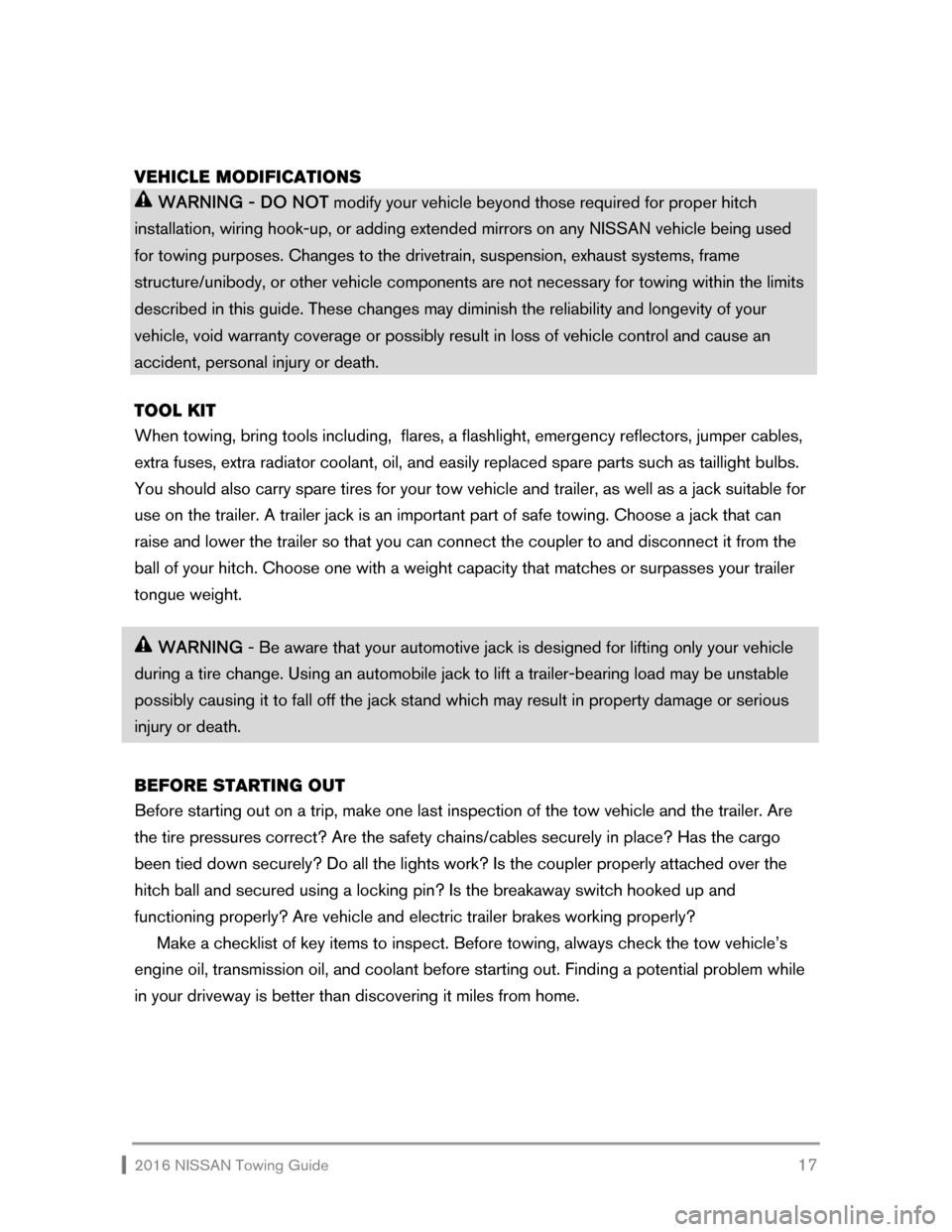oil NISSAN 370Z ROADSTER 2016 Z34 Towing Guide
[x] Cancel search | Manufacturer: NISSAN, Model Year: 2016, Model line: 370Z ROADSTER, Model: NISSAN 370Z ROADSTER 2016 Z34Pages: 27, PDF Size: 0.55 MB
Page 11 of 27

2016 NISSAN Towing Guide 10
CAUTION- The NISSAN trailer brake controller has been verified to be compatible with
trailers having electric actuated drum brakes (one to four axles) and electric- over-hydraulic
brakes. It will not activate hydraulic surge-style trailer brakes.
SWAY CONTROL DEVICE
Sudden maneuvers, wind gusts, and buffeting caused by other vehicles can affect trailer
handling. Sway control devices may be used to help control these effects. If you choose to
use one, contact a reputable trailer hitch supplier to make sure the sway control device will
work with the vehicle, hitch, trailer and the trailer’s brake system.
GENUINE NISSAN PARTS AND ACCESSORIES
Whether you will be towing occasionally or on a regular basis, NISSAN offers a full range of
Genuine NISSAN Parts and Accessories to help you tow with confidence.
Every Genuine NISSAN Parts and Accessory is thoroughly tested and inspected for fit and
workmanship. Therefore, you can be certain that every item is designed to be compatible with
the standard features of your vehicle and designed to assist you with your towing needs.
It is recommended you contact your NISSAN dealer for more information on accessories or
towing-related parts for your NISSAN vehicle.
PREPARING
YOUR VEHICLE
BREAK-IN AND MAINTENANCE SCHEDULE
CAUTION- NISSAN recommends that you allow a sufficient “break-in” (500 miles) of both
the engine and drivetrain before towing with your new NISSAN vehicle. Do not tow a trailer or
haul a heavy load for the first 500 miles. For the first 500 miles that you tow a trailer, do not
drive over 50 mph and do not make starts at full throttle. This helps the engine and other
parts of your vehicle wear in at heavier loads.
Keep in mind, too, that towing places higher demands and added loads on vehicle
components, so more frequent maintenance is called for. Your NISSAN Service &
Maintenance Guide provides the accelerated maintenance schedule for towing purposes.
Engine oil, filter, transmission fluid, and possibly other fluids should be changed more
frequently when towing.
MEASURING VEHICLE WEIGHT
The key to safer, efficient towing has to do with weight. Your vehicle — SUV, crossover, truck
or passenger car — is capable of carrying and towing only a certain amount of weight. You
Page 18 of 27

2016 NISSAN Towing Guide 17
VEHICLE MODIFICATIONS
WARNING - DO NOT modify your vehicle beyond those required for proper hitch
installation, wiring hook-up, or adding extended mirrors on any NISSAN vehicle being used
for towing purposes. Changes to the drivetrain, suspension, exhaust systems, frame
structure/unibody, or other vehicle components are not necessary for towing within the limits
described in this guide. These changes may diminish the reliability and longevity of your
vehicle, void warranty coverage or possibly result in loss of vehicle control and cause an
accident, personal injury or death.
TOOL KIT
When towing, bring tools including, flares, a flashlight, emergency reflectors, jumper cables,
extra fuses, extra radiator coolant, oil, and easily replaced spare parts such as taillight bulbs.
You should also carry spare tires for your tow vehicle and trailer, as well as a jack suitable for
use on the trailer. A trailer jack is an important part of safe towing. Choose a jack that can
raise and lower the trailer so that you can connect the coupler to and disconnect it from the
ball of your hitch. Choose one with a weight capacity that matches or surpasses your trailer
tongue weight.
WARNING - Be aware that your automotive jack is designed for lifting only your vehicle
during a tire change. Using an automobile jack to lift a trailer-bearing load may be unstable
possibly causing it to fall off the jack stand which may result in property damage or serious
injury or death.
BEFORE STARTING OUT
Before starting out on a trip, make one last inspection of the tow vehicle and the trailer. Are
the tire pressures correct? Are the safety chains/cables securely in place? Has the cargo
been tied down securely? Do all the lights work? Is the coupler properly attached over the
hitch ball and secured using a locking pin? Is the breakaway switch hooked up and
functioning properly? Are vehicle and electric trailer brakes working properly?
Make a checklist of key items to inspect. Before towing, always check the tow vehicle’s
engine oil, transmission oil, and coolant before starting out. Finding a potential problem while
in your driveway is better than discovering it miles from home.